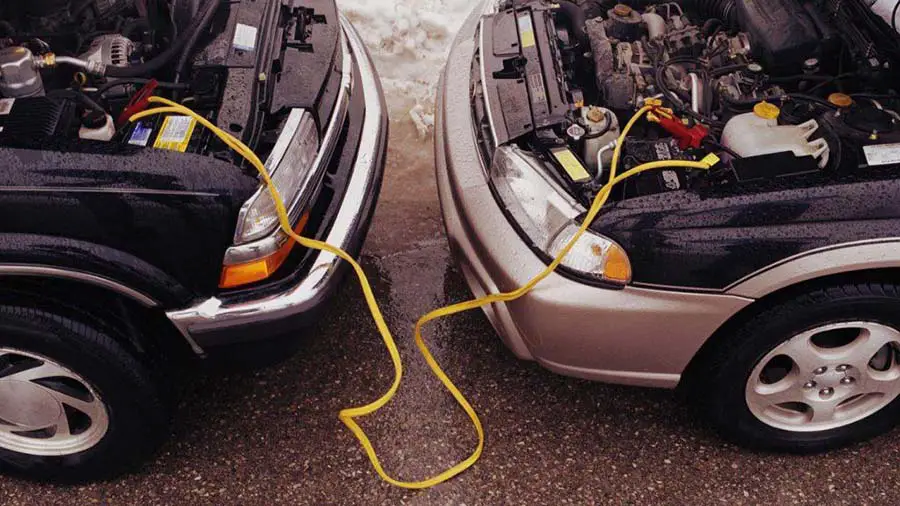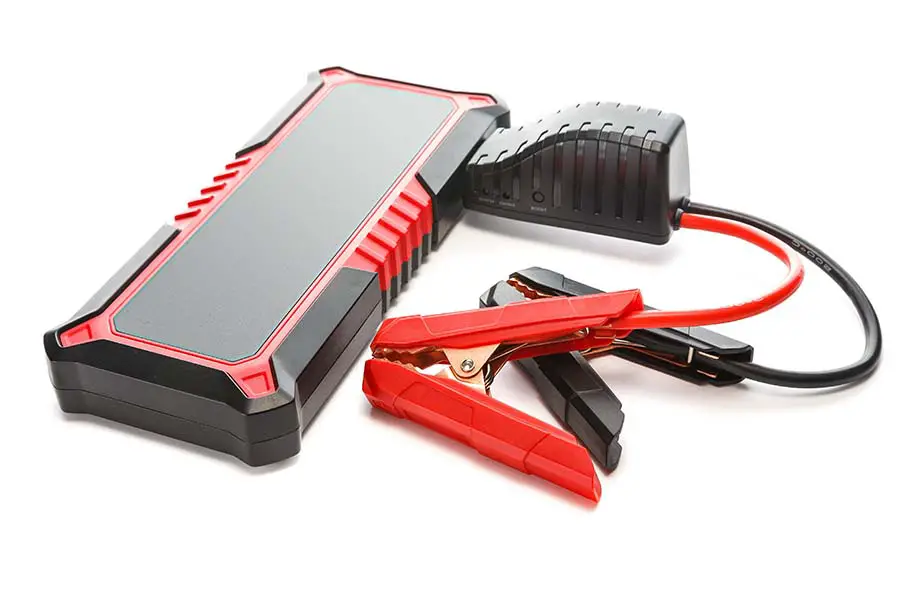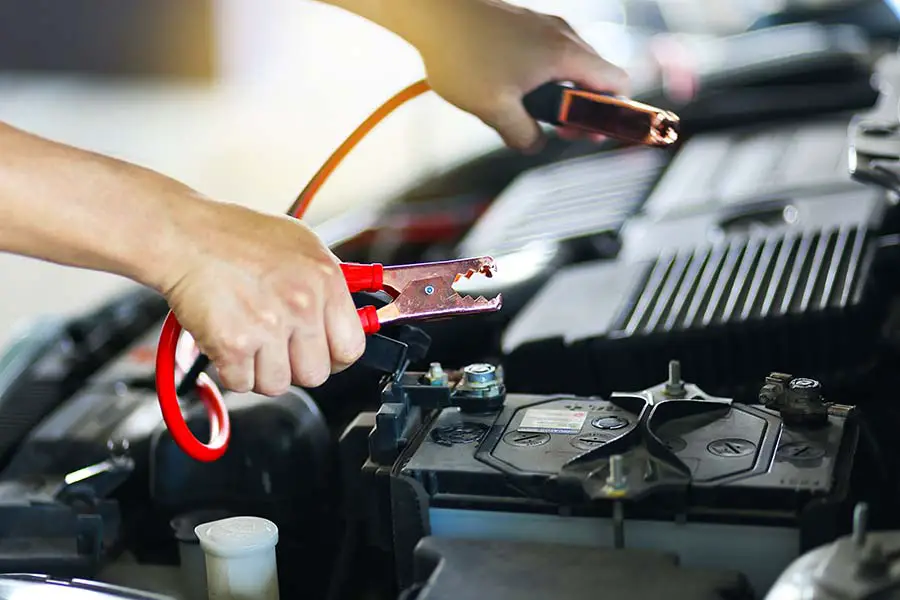It’s best to charge your battery periodically and keep track of its power stage to ensure there’s always enough juice to power your vehicle. However, the real world is far from ideal, and you may find yourself with a dead battery someday.
How To Charge A Car Battery Without A Charger?
1. Using Jump Leads
Jump leads are a pair of electric jumper cables with metal clamps at either end. They help you charge your car dead battery enough to go to your destination or anywhere you can recharge it properly. To conduct this method, you need help from another vehicle as well.
Here’s how to charge your car battery with jumper cables:
- Dust the battery terminals to remove rust, dirt, and debris. Put on protective eyewear.
- Ensure both car engines are off, in Park or Neutral mode.
- Use one cable to connect the positive terminal of your battery with that of the other vehicle.
- With the second cable, attach one of its ends to the negative terminal of the donor battery and the other end to a piece of unpainted metal.
- Wait a few minutes for the battery to charge, which usually takes 5 minutes.
2. Using Another Vehicle

Charging your car battery using a donor vehicle means putting your dead battery into another car for charging.
This is also how to charge a 12V battery without a charger, which is much easier than using jump leads. Yet, both vehicles have to use the same battery model for compatibility so that you can place the battery in its correct position.
If you try to pack your battery into an incompatible car, it may be useless and damage your battery and the other vehicle.
3. Using A Portable Jump Starter

A jump starter is a portable device designed for jump-starting vehicles. This portable battery charger is like a backup battery pack for your car.
It comes in handy when your car battery has run out of juice completely, and you cannot call towing services.
To recharge your battery with a jump starter, do the following things:
- Put on protective gear, like gloves and eye protection.
- Turn off the car engine. The charger must be off, too. Then, remove any jewelry you’re wearing, and make sure you’re at a safe position, and your face is not close to the battery.
- Place the portable charger a distance from the battery, as far as its cord allows.
- Attach the red clamp of the charger to the battery’s positive port.
- Connect the black clamp (negative clip) to a piece of unpainted metal.
- Once connections are firmly established, turn on the jump starter.
- Try starting the car, but don’t crank it for more than 5 seconds. If the engine doesn’t kick off, wait another 2 to 3 minutes before trying again.
4. Using UPS Power Inverter

A UPS inverter can convert the DC power of the battery into AC current. It’s often used as a backup power source for household appliances, such as the phone charger and laptop charger when the light is out.
You can also use a UPS inverter to charge your car battery. Fortunately, most inverters have built-in safety features to monitor the battery’s voltage, preventing overheating and overcharging.
That said, remember to read the manual before working with the device.
See more: Are Car Batteries AC or DC?
5. Using A Battery Isolator
Battery isolators are more popular among campers and RV drivers. They transfer electricity from a primary car battery, previously charged by an alternator, to a flat battery.
These are not as strong as an actual car battery charger, and it may be hard to apply this method if your battery is dead. However, it still works and can help you recharge your car battery enough to start the engine.
6. Using Solar Panels And Solar Chargers
Solar energy is an endless power supply to rely on. You can charge anywhere you are, as long as it’s daylight. The downside is that the charging process may take several hours. If you don’t mind slow charges, this method is useful.
When shopping for a solar charger for your car battery, don’t forget to check and make sure it matches the size of your flat battery. This way, you can minimize the charging time.
What To Prepare Before Charging
Stay Away From Fire Triggers
Before you charge your car battery, ensure that you are in an area with no flames, sparks, or smoke nearby. Stay away from anything that can cause fire hazards. Also, take off your jewelry and wear protective gear.
Make Sure The Battery Is Not Leaking
Take a sniff around your dead car battery. If you notice some smell similar to rotten eggs, there may be a gas leak somewhere. It’s extremely dangerous to you, the car, and anyone close to the vehicle.
In this case, don’t charge your dead battery, ensure there’s nothing in the proximity that can start a fire, and steer away from the car. Then, call for professional help.
View more: Can A Car Battery Be Too Dead To Jump Start?
Cool Down The Battery
Not many people pay attention to this when they are in a rush to charge their car batteries. However, you must always check for heat in the battery before charging.
Your battery can easily get hot in warmer weather if your car is parked under direct sunlight. In other cases, your car battery tends to overheat when it works extensively.
It’s not safe to charge it in this condition. You need to cool down the battery first.
Check For Corrosion
Another safety risk coming with car battery charging is degraded batteries. Therefore, check it for signs of corrosion, such as crusty, greenish substance around the battery ports.
This substance is created when the battery acid fume is exposed to the air, which often happens with lead-acid batteries. Those who own this type of battery must pay close attention because it can negatively affect the charging efficiency.
How To Know Your Car Battery Needs Charging?
Your Car Won’t Start
Normally, you should be able to start your car with a simple turn of the key. If you have to turn the key multiple times before the engine starts or it doesn’t start, it’s a sign that your dead battery needs charging.
Car Electrics Don’t Work Properly
Your car battery powers all the electrics in your car, including lights, windows, heaters, infotainment system, etc. Therefore, when they don’t respond as quickly to your control, you should take the battery into account.
There’s a likelihood that the battery has run out of power, making all the electrics weak, and preventing them from operating normally.
For more: 8 Signs Your Car Battery Is Dying
Battery Warning Light Is On
On the car dashboard, there’s a dedicated battery light that turns on when there’s something wrong with the alternator, electrical system, or battery.
Whenever this light is on, it means your battery is not being charged right, and it can run out of juice anytime.
The first thing to do in this case is to check your car battery and make sure to recharge it.
The Start-Stop Function Doesn’t Work
The start-stop system in your car is responsible for battery monitoring and detecting the current drawn from it. If the battery struggles, the function will be disabled to avoid draining the battery too much.
Conclusion
To charge a car battery without a charger, you can use jump leads, a jump starter, solar charger, UPS inverter, battery isolator, or charge it in another car.
Before charging your battery, you should make sure the battery is really out of juice, not broken. In addition, always put safety first, wear protective gear, and don’t stay too close to the battery during the process.









0 Comments